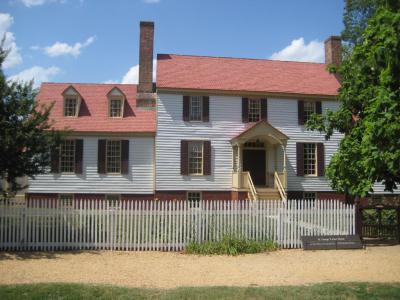
St. George Tucker House, Williamsburg
Constructed in 1718–19 for William Levingston, who notably built the first theater in America, this house eventually passed into the hands of St. George Tucker, a prominent figure in Virginia's legal and academic spheres. Upon relocating from Bermuda to Williamsburg, Tucker, a lawyer and law professor at the College of William and Mary, made substantial contributions to the development of American jurisprudence.
Judge Tucker's impact extended beyond the confines of his legal career, as evidenced by his advocacy for the abolition of slavery in Virginia. In his controversial 1796 pamphlet addressed to the General Assembly, Tucker articulated a plan to end slavery, emphasizing its importance for the moral character of Virginians. This bold stance underscored Tucker's commitment to advancing principles of justice and equality, leaving an indelible mark on the state's history. Additionally, Tucker's 1803 edition of "Blackstone's Commentaries" emerged as a seminal work in American legal education, solidifying his legacy as a pioneering legal scholar.
Over the years, the St. George Tucker House underwent significant expansions and modifications under the stewardship of Tucker and his descendants. These alterations, including the addition of chimneys, a second story, east and west wings, a kitchen, and bathrooms, reflected the changing needs of Tucker's growing family. Nathaniel Tucker, St. George's son, continued this tradition of architectural adaptation, further enhancing the house's stature within the community.
Judge Tucker's impact extended beyond the confines of his legal career, as evidenced by his advocacy for the abolition of slavery in Virginia. In his controversial 1796 pamphlet addressed to the General Assembly, Tucker articulated a plan to end slavery, emphasizing its importance for the moral character of Virginians. This bold stance underscored Tucker's commitment to advancing principles of justice and equality, leaving an indelible mark on the state's history. Additionally, Tucker's 1803 edition of "Blackstone's Commentaries" emerged as a seminal work in American legal education, solidifying his legacy as a pioneering legal scholar.
Over the years, the St. George Tucker House underwent significant expansions and modifications under the stewardship of Tucker and his descendants. These alterations, including the addition of chimneys, a second story, east and west wings, a kitchen, and bathrooms, reflected the changing needs of Tucker's growing family. Nathaniel Tucker, St. George's son, continued this tradition of architectural adaptation, further enhancing the house's stature within the community.
Want to visit this sight? Check out these Self-Guided Walking Tours in Williamsburg. Alternatively, you can download the mobile app "GPSmyCity: Walks in 1K+ Cities" from Apple App Store or Google Play Store. The app turns your mobile device to a personal tour guide and it works offline, so no data plan is needed when traveling abroad.
St. George Tucker House on Map






Sight Name: St. George Tucker House
Sight Location: Williamsburg, USA (See walking tours in Williamsburg)
Sight Type: Attraction/Landmark
Guide(s) Containing This Sight:
Sight Location: Williamsburg, USA (See walking tours in Williamsburg)
Sight Type: Attraction/Landmark
Guide(s) Containing This Sight:
Walking Tours in Williamsburg, Virginia
Create Your Own Walk in Williamsburg
Creating your own self-guided walk in Williamsburg is easy and fun. Choose the city attractions that you want to see and a walk route map will be created just for you. You can even set your hotel as the start point of the walk.
Williamsburg Introduction Walking Tour
Williamsburg, an independent city in Virginia, was founded by English settlers in 1632 – originally as a fortified settlement called Middle Plantation, on the high ground between the James and York rivers.
The local College of William & Mary, established in 1693, is the second-oldest institution of higher education in the United States. Its alumni include three US presidents as well as... view more
Tour Duration: 3 Hour(s)
Travel Distance: 3.4 Km or 2.1 Miles
The local College of William & Mary, established in 1693, is the second-oldest institution of higher education in the United States. Its alumni include three US presidents as well as... view more
Tour Duration: 3 Hour(s)
Travel Distance: 3.4 Km or 2.1 Miles

